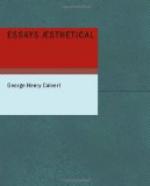As men have body, intellect, and moral natures, so is there physical, intellectual, and spiritual beauty, and each distinct from the others. Take first a few examples from the domain of art. The body and limbs of the Gladiator in the Louvre may be cited as the exponent of corporeal beauty; the face of the Apollo Belvedere as that of intellectual and physical; and the Santo Sisto Madonna of Raphael, and the Christ of the Last Supper by Leonardo da Vinci, for spiritual. Through these radiant creations we look into the transcendent minds of their artists with a chastened, exalting joy, not unmingled with pride in our brotherhood with such beauty-lifted co-workers with God.
Among the higher races, life is affluent in examples of the three kinds of beauty, two of them, and even all three, at times united in one subject. Children and youth offer the most frequent instances of physical beauty. Napoleon’s face combined in high degree both physical and intellectual, without a trace of moral beauty. Discoveries in science, and the higher scientific processes, as likewise broad and intense intellectual action, exemplify often intellectual beauty. Of moral beauty history preserves examples which are the brightest jewels, and the most precious, in the casket of mankind’s memory; among the most brilliant of which are the trust of Alexander, when he drank the draught from the hand of his physician, though warned that it was poisoned; the fidelity of the paroled Regulus, returning from Rome to the enemy into the jaws of a certain and cruel death; Sir Philip Sidney, wounded unto death, taking the cup of water untasted from his parched lips, to give it to a dying soldier; Luther at the Diet of Worms; the public life of Washington; the life and death of Socrates, and especially that last act of washing his body to save the women the trouble of washing it a few hours later, when it would be a corpse; and, lastly, that most beautiful of lives and most sublime of deaths, which live in the heart of Christendom as its exemplar and ever fresh ideal.




